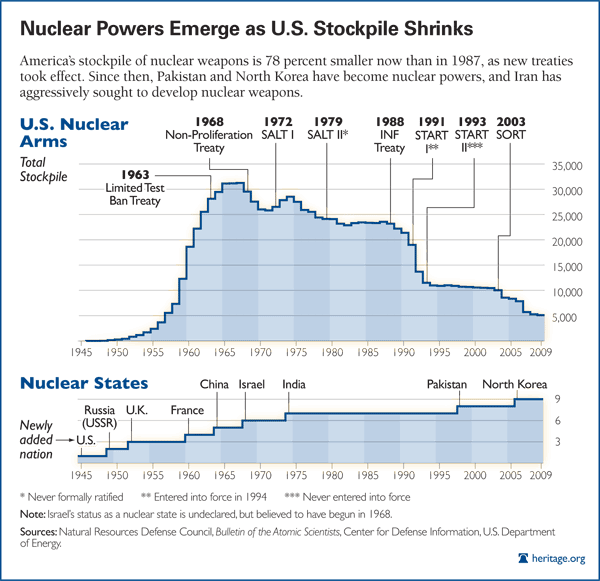THE ISSUE:
The first duty of the U.S. government is to protect the American people. The spread of ballistic missile technology and the existence of nuclear weapons programs in states such as North Korea and Iran make fulfilling this duty more urgent than ever. During the Cold War, the U.S. protected Americans by threatening devastating retaliation against any enemy who attacked the U.S. or its allies. Today, the U.S. needs a new strategy, a positive vision that combines verifiable arms control, missile defense, a modernized arsenal, and responsible non-proliferation diplomacy. This “protect and defend” strategy is a modern realization of President Ronald Reagan’s vision of “peace through strength.”
- The Threat Is Real. Nations around the world are developing ballistic missile technology and nuclear weapons that will allow them to directly threaten the United States. America’s allies are already at risk.
- The U.S. Is Vulnerable. The Administration has backed away from plans to introduce a comprehensive system of missile defense that would protect both the U.S. and its allies. Instead, it has relied on flawed diplomacy, confusing strategic visions, an aging nuclear arsenal, and limited defensive systems.
- Arms Control Is Not the Answer. The purpose of arms control agreements is to improve the security of the United States, not to demonstrate our goodwill to foreign regimes. Since the late 1960s, the U.S. has reduced its nuclear stockpile by over 80 percent. This has done nothing to halt the rise of other nuclear powers.
- Retaliation Alone Is Not the Answer. The Cold War vision of deterrence required the U.S. to use nuclear weapons to destroy the population and economic infrastructure of any enemy that attacked it with such weapons. The U.S. can and should do better. Our ultimate goal should be to shift to a deterrence-oriented strategy, one that presumes that reliance on nuclear weapons will be reduced over time. It should be to protect and defend our people and our allies.
- Modernize the U.S. Nuclear Arsenal. The U.S. will have nuclear weapons in its arsenal for the foreseeable future. These weapons should be modern so that they can be maintained safely and relied on to perform effectively. Failing to invest in the nuclear arsenal leads to atrophy of the U.S. scientific and technical base and forces the U.S. to deploy old weapons that both reduce its strategic options and trap it in outdated policies of massive retaliation.
- Deploy Comprehensive Missile Defense. The purpose of missile defense is to protect the American people and America’s allies. No American could object to this. If other states object to this, that is evidence of their desire to achieve their strategic aims by threatening the United States. The U.S. should continue an active and wide-ranging program of research and development and should immediately deploy a comprehensive system of missile defense that will protect U.S. forces in the field, U.S. allies, and the American homeland.
- Don’t Sign New START. The U.S. Senate should not ratify the New START treaty signed by Presidents Barack Obama and Dmitry Medvedev. The treaty contains inadequate verification; constrains the U.S. ability to develop and deploy missile defenses; allows Russia to increase its deployed strategic nuclear delivery systems while America is forced to cut; and while U.S. policy stops the construction of new nuclear warheads, Russia and China can move ahead with robust modernization efforts.
- Take Proliferation More Seriously. The United States should continue efforts like the Proliferation Security Initiative that have proven their value and resulted in the disarmament of Libya. It should also recognize that the most successful way to control and limit the spread of nuclear weapons and other weapons of mass destruction is to defend and advance freedom around the world: The fall of the Soviet Union was non-proliferation’s greatest moment. The U.S. should seek to return the Non-Proliferation Treaty regime to a central focus on non-proliferation.
- Return to Peace Through Strength. Weakness and strategic vulnerability do not create peace. They create opportunities for unfriendly and opportunistic states to blackmail America and threaten its allies. In rebuilding and modernizing its arsenal, its defenses, and its diplomacy, the U.S. will preserve and spread peace by adopting a protect and defend strategy and bringing into the 21st century Ronald Reagan’s vision of “peace through strength.”


